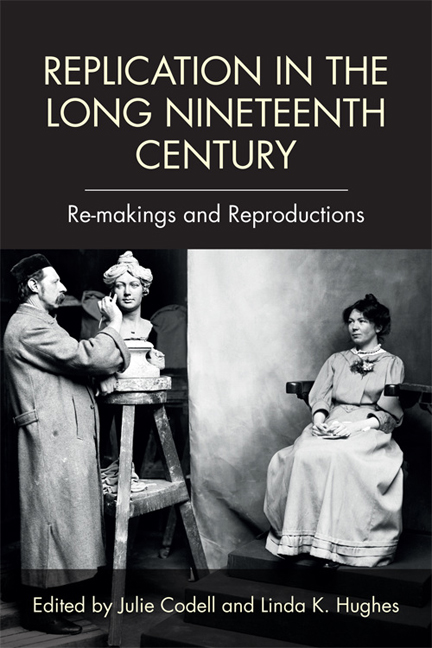Book contents
- Frontmatter
- Contents
- List of Illustrations
- Acknowledgments
- 1 Introduction: Replication in the Long Nineteenth Century – Re-makings and Reproductions
- I Replication and Networks
- II Replication and Technology
- 6 Replicating Tennyson's The Princess, 1847–1853
- 7 Paisley / Kashmir: Mapping the Imitation-Indian Shawl
- 8 William Morris and the Form and Politics of Replication
- 9 Text and Media Replication During the U.S.–Mexican War, 1846–1848
- III Replication and Authenticity
- IV Replication and Time
- Notes on Contributors
- Index
6 - Replicating Tennyson's The Princess, 1847–1853
from II - Replication and Technology
Published online by Cambridge University Press: 11 August 2018
- Frontmatter
- Contents
- List of Illustrations
- Acknowledgments
- 1 Introduction: Replication in the Long Nineteenth Century – Re-makings and Reproductions
- I Replication and Networks
- II Replication and Technology
- 6 Replicating Tennyson's The Princess, 1847–1853
- 7 Paisley / Kashmir: Mapping the Imitation-Indian Shawl
- 8 William Morris and the Form and Politics of Replication
- 9 Text and Media Replication During the U.S.–Mexican War, 1846–1848
- III Replication and Authenticity
- IV Replication and Time
- Notes on Contributors
- Index
Summary
Demonstrating his faith in new technologies, Tennyson invested in a wood-carving enterprise meant to replicate mechanically handcarved furniture in the 1840s (Hallam Tennyson 1:220–1). The business's failure left him depressed and in financial straits, but his faith in technology remained – appropriately so, for reliance on high-speed replication was essential for his first long poem to attain popularity. From the moment it appeared on Christmas Day in 1847, Tennyson's The Princess was at once welcomed and entirely unexpected. In 1842 Tennyson had become the foremost poet of his generation with his two-volume Poems, which included the dramatic monologues “Locksley Hall” and “Ulysses,” and lyrics such as “Break, break, break.” Five years later, no one expected a 164-page blank-verse poem with a prologue, conclusion, and seven-book inset tale. The Princess, ostensibly narrated by seven college men on holiday at a country estate, concerns a rebellious princess who spurns arranged marriage and establishes an all-female university from which men are excluded on pain of death, only to capitulate at the tale's end to impending marriage with the Prince.
Twenty-two years before the first woman's college opened at Cambridge, Tennyson had clearly taken up “the woman question,” or how women's roles were to change in the face of democratic reforms and rapid developments in science and technology. By embedding his quasi-medieval tale within a prologue and epilogue that emphasized contemporary social change and technology, Tennyson could underscore the analogous juxtaposition in contemporary Britain of longstanding traditions and artifacts with startlingly diverse innovations from the rail system (begun only eleven years earlier) to the Chartist movement, which was led by workers and their allies who demanded universal male suffrage along with other reforms. The prologue is accordingly set on a country estate but Sir Walter Vivian, the squire (father to one of the college men), has opened it to tenants and workers belonging to a neighboring Mechanics’ Institute. Inside Sir Walter Vivian's elegant home are displays of ancestral memorabilia and a connoisseur's collection of artifacts gathered from “every clime and age,” but outside are scientific displays set up for workers’ amusement and instruction, including a miniature steam paddleboat and steam railway, a telescope, and a cannon set off remotely by “knobs and wires and vials” (The Princess 1847: 2, 4).
- Type
- Chapter
- Information
- Replication in the Long Nineteenth CenturyRe-makings and Reproductions, pp. 103 - 121Publisher: Edinburgh University PressPrint publication year: 2017



